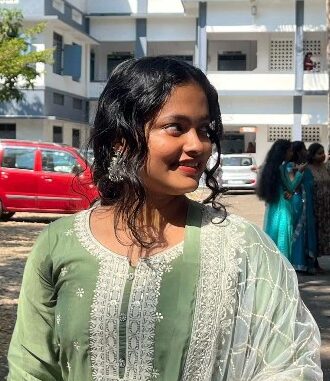Shri Chandraprabha Digambara Jain Temple, a millennium-old temple, is located in Jainimedu along the banks of the Kalpathy River, approximately 3 kilometers from Palakkad, Kerala, India. This temple is among the few remaining examples of traditional Jain architecture in Kerala. It is made up of huge granite blocks.

As per local lore, the three merchant brothers, Ijjana Shetty, Payappa Shetty, and Chikuppaya Shetty, journeyed to Palakkad, where the youngest, Chikuppaya Shetty, passed away from an illness. The loss profoundly affected his two siblings. Subsequently, they sought the guidance of Elacharya Muni, a Jain Saint, and constructed a temple in accordance with his counsel. It is reported that around 400 Jain families resided in the vicinity, but following the invasion by Tipu Sultan, only a handful managed to survive.
DIETIES AND ARCHITECTURE

The main altar is simple and unembellished. The temple’s pillars and roofs feature intricate carvings of symbols such as the Swastika, elephant, deer, and lotus (Padma), all expertly sculpted. The building consists of four divisions, or ‘aras’, characterized by walls that lack elaborate ornamentation. The temple is dedicated to Chandraprabha, the eighth Tirthankara of Jainism, and is crafted from Rajasthani Chandrashila. Nearby the principal idol, one can find sub-shrines dedicated to Padmavatidevi, Jwalamalinidevi, Vijayalaksmi, Brahmadeva, Rishabhanadan, and Parswanathan. Additionally, the Ashta Dikpalakas, the guardians of the directions, and Nagas are also present.
The temple underwent renovations from 2009 to 2013, during which the pillars and roofs of the Kalasamandapa and the garbhagriha were constructed. Detailed restoration efforts were carried out. Historical accounts suggest that there were originally 24 wells, but the majority were destroyed during Tipu’s invasion, leaving only one remaining well. This well is constructed from large granite blocks and features a stone carving of an elephant, which symbolizes Ajitnatha, the second Tirthankara.
RITUALS AND FESTIVALS

In the early morning, a ritual known as Ashtagajarchana takes place, where a blend of rice and dried fruits is presented to the idol. Additional ceremonies include Jalabhishekam, Palabhishekam, Nithyapuja, Aarathi, and Neyvilak. A saree, which is a traditional garment for women, is also offered to the Devi (Female Goddesses). The Namokara Mantra is chanted three times to seek the deity’s blessings.
Mahavira Jayanti is observed in April, and Akshaya Tritiya is celebrated as an annual Jain festival. The Pratishta Mahotsav (idol consecration) occurs every year on May 13. For this occasion, Kalasapooja is performed, where kalasas (pots) are placed at the Kalasamandapa, along with other rituals such as Gangabhishekam, Malarabhishekam, and Palabhishekam. During Navaratri, a 10-day pooja and Saraswati pooja are also conducted.
Two memorials have been established to honor the two brothers. Several large stones are located in proximity to the temple. A rock-like stone featuring engravings is also found nearby. The temple is managed by the Manika Pattanam Sree Chandraprabha Digambara Basti Trust.

The writer, Theertha Satheesh, is from Palakkad, Kerala. She has a degree in Archaeology and Museology. She has gained hands-on experience in archaeological fieldwork through an excavation project at Padta Bet, Gujarat, conducted by the University of Kerala and Anappara excavation at Idukki, Kerala conducted by KCHR. She aims to contribute to the field of archaeology, bridging the gap between past and present.
